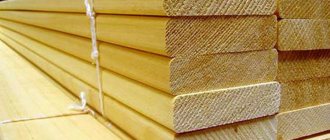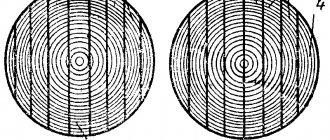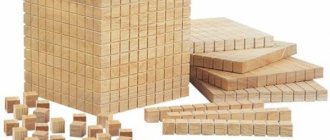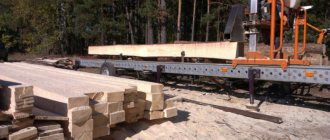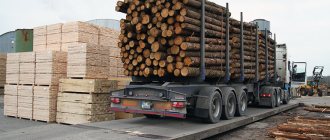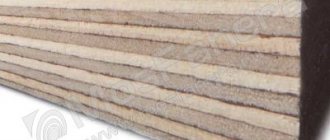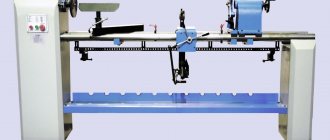Logging is a large-scale process of preparing logs and then delivering them to the customer for construction or to a wood processing plant. Until delivery, there will be a cycle of interconnected processes, the quality of which determines the safety of the wood.
There are two harvesting methods: manual and mechanized.
Manual logging
This type of work is considered one of the most dangerous. People who have not been trained and have not studied safety precautions are not allowed to access it. The equipment, in addition to special shoes, clothing and a helmet, includes measuring devices and carrying equipment. The actions performed per cycle are identical for any method:
- site preparation;
- cutting;
- cutting the upper unused part, branches;
- debarking (bark is removed at the enterprise; if further use of the wood is intended as kindling, then this stage is excluded);
- skidding (moving logs closer to the road);
- bucking (sawing the logs crosswise);
- sorting, stacking, loading, transportation.
Manual work on the workpiece begins with determining the direction in which the cut trunk will fall. The felling is planned in such a way as to minimize the dragging of logs.
The tree is cleared of excess - growths around the butt, branches, and is slightly sawn on the side in which it should fall (about 1/15 of the thickness of the trunk), and on the other, a felling tree is sawn, which is fixed to control the fall. The rules for carrying out such developments state that the cut should not be lower than the undercut. The distance between them must remain sufficient for successful felling.
It is necessary to take into account the slope: the distance the top deviates from the butt will be equal to the distance the trunk falls away from the planned location. The branches are cut individually or several at once. The feller performs crosscutting as the trunk is cleared of branches. The remains of wood on the cut-down plot are distributed along skids and kneaded with tractors, laid in shafts with an interval of 20 m, or evenly distributed throughout the site.
Deforestation rules allow a single felling of trees if it is carried out according to a certified plan. Sick, old, unsuitable trees for construction are marked by the forester, after which they are cut down by fellers.
Procurement using machines
The method uses modern technologies using sawmills. One harvester requires two forwarders. The first one cuts, cleans and cuts, creating 4-6 m long logs that are easy to transport.
Harvester
A harvester harvests as much timber for construction in a day as a specialist with a chainsaw can handle in 5-6 days - approximately 10 tons. The combine is controlled by joysticks: the first controls the manipulator, and the second regulates the operation of the head, which performs the processing.
The tree is clamped on both sides by grippers and rollers, and pulled through the head, simultaneously cleared of branches. The result is a finished log, cut and sawed with a saw built into the manipulator. The length of the blades is adjusted using computer technology that controls the cutting pitch.
After completion of each stage, the monitor emits a red color signal. The actions of the harvester can be summarized as follows:
- arrival at the planned plot;
- bringing the processing head to the barrel, windrow;
- cutting branches, bucking;
- service breaks;
- elimination of undergrowth.
Working on one whip takes no more than a minute. This depends on the thickness of the cut and the training of the operator.
Forwarder
The forwarder collects ready-made whips. Its manipulator is much more powerful, as it is designed to grab up to 7 logs at the same time. The machine does not overturn due to the large lifting mass due to its own weight, depending on the model, ranging from 13 to 20 tons. Any equipment intended for harvesting wood is weighted as much as possible precisely for this purpose. The excellent cross-country ability of the all-wheel drive vehicle is achieved thanks to four pairs of drive wheels, onto which an aluminum track is attached if necessary.
Harvesters operate around the clock. If necessary, pauses are made during which the machines receive the necessary maintenance. The rules for operating a forwarder or harvester imply a shift duration for the operator not exceeding 12 hours. During this time, up to 500 trees are processed, after which they are transported to the site for further processing.
Both types of combines can be divided into several groups, each of which is designed to develop a forest belt of a certain type. Small machines weighing 7-12 tons can capture up to 750 kg of wood, and it is more reasonable to use them for thinning a plot, since on large trunks the manipulator and saws quickly fail. Larger units weighing 13-17 tons are used for the second thinning and the main functioning of the plot.
For the average volume of forest, universal machines are used. Heavy 20-ton combines harvest a mass of 1200 kg, but they are rather clumsy and are not intended for use as thinners. New technologies make it possible to produce single-grip harvesters that process the trunk with one manipulator with a head, without the need for an additional device attached to the frame. The boom length is from 7 to 10 meters, which allows you to work on an area 14-20 meters wide.
Organization and implementation of timber harvesting work
Harvesting of timber includes cutting down, skidding, necessary processing, storage and removal from the harvesting site. This activity is permitted in protective and operational forests. These works are carried out by the owners or buyers of plots, in accordance with the procedure for harvesting wood. In the first case, it is considered economic.
Temporary accommodation points for loggers are installed on the plot to reduce costs and time for their transportation. If retail sales of sawn timber and its processed products are planned at a cutting site, then offices, warehouses, etc. are built. Most of us understand that manual logging is a thing of the past. Now this work (especially on large workpieces) is performed by computerized equipment: harvester, forwarder. It is managed by operators specializing in forestry. The harvester can cut trees, remove branches, cut them into pieces - it can do all this within a minute. A forwarder is a loader-tractor, with the help of which wood is loaded and transported to loading areas. In this case, the operator sits in a warm cabin, performing work in comfortable conditions.
The area of loading areas in through-cutting areas is determined when delimiting the cutting area. If loggers organize them arbitrarily, outside the boundaries of the plot, then the destruction of forest plantations occurs. Even if it is an empty site, such actions are still considered a violation of Forest Law.
Sorting and temporary storage
Timber harvesting can be carried out using long-length and cut-to-length, or “Scandinavian” methods. In the first case, which is most often used in areas with an undeveloped transport system, it is more profitable to remove trees felled for construction in large unprocessed lots. The final cleaning and sawing will be carried out not in the forest, but closer to the customer.
Using assortment technology, sorting by species, quality and caliber is carried out on the plot. Cutting into logs is carried out in the presence of a fairly developed road system, which makes it possible to bring the finished timber to the customer practically from the felling site.
Regardless of what method is used when harvesting wood - manual or mechanized - sorting is required. The logs are stacked in stacks that are easy for the loader to grip. Same-breed assortments that are similar in appearance can be crosscut for different customers. If the built-in technologies of harvesters allow, then a colored marking strip is applied to the end of each log.
Manual logging involves storing logs on the site. If skidding is carried out with a small forwarder, then the logs can be laid directly on the plot. If the manipulator is large, then the logs are stacked in the felling area. If the work excludes the use of chainsaws, then there is no fundamental difference in where the logs are stored.
A nuance that applies to both methods is that the pulpwood must be laid out in packs as carefully as possible, since for further use of this type of wood it is necessary that there are no chips on them. The packs are arranged as conveniently as possible for the manipulator. If the operator has enough experience in operating the harvester, then the bundles will be laid out on both sides of the drag so that subsequent work of the forwarder does not damage the trees or be delayed due to the inconvenient arrangement of the logs.
Rules for the allocation and taxation of cutting areas
Rules for the allocation of logging areas include the selection of trees for further cutting and restrictions on forest planted areas for timber harvesting. In cases of private harvesting, work without marking the boundaries of cutting areas is allowed - felling for the maintenance of a forest belt:
- These types of work are carried out only if there is a lease or purchase and sale agreement for the forest plot.
- Or by government agencies at the federal level on the basis of continuous use.
- Logging operations are carried out only in the forest area.
- If the forest is operational, then the felling area can be increased by collecting overmature and dried trees that are subject to destruction (maximum 3 hectares)
- Work on the allocation and taxation of cutting areas includes registration of young growth of target (main) tree species.
- The following types of young trees are preserved during these types of work: ash, oak, beech, linden, pine and others.
The allotment of continuous cutting areas excludes:
- cutting down plants protected by environmental legislation;
- such zones in the forest as swamps, clearings, clearings;
- insemination zones;
- ripe and dried areas of forest plantations, including young growth.
The boundaries of the plot are drawn using special geodetic instruments, which determine the logging sites with an error of no more than 4%. After this, a pillar about 1.5 meters high with a sign is installed in the corner of the allocated area. It indicates the year of felling, area, square number and type of felling. The remaining corners are marked with posts with marks (tape, paint, etc.).
Taxation is the determination of the quantity and quality of wood growing in a designated cutting area. The permissible error is:
- for a certain type of tree – up to 12%;
- for the total number – up to 10%.
If the amount of wood cannot be determined before felling, then this is done after harvesting work.
Skidding
To carry out this stage, a forwarder or tractor is used: skidding or conventional. The latter is undesirable and is used very rarely due to its low power. The agricultural tractor is used for collecting firewood or small movements of logs for construction. Skidding can be divided into several stages:
- travel to the loading place;
- the actual collection of harvested timber;
- moving cargo to the warehouse.
Loading and unloading work takes up most of the time. The duration of skidding is also affected by the number of assortments. In winter, they need to be removed immediately; in summer, storage on the site for 2-3 days is allowed.
Transportation, storage, standards
Transportation of wood can be carried out by all types of transport, except air. Each has its own characteristics:
- by water: slow, but cheap, only if there are large rivers;
- by rail: faster and more expensive than by river, but at the same time the railway system is more extensive than large water arteries;
- auto: mainly for valuable species, the most expensive method.
For construction, as in other areas of timber use, high-quality material without cracks, chips or other deformation is suitable. There are rules, the observance of which will preserve the workpieces:
- laying is done in the form of stacks;
- installation of a canopy or film cover is required;
- A ventilated gap is required between the floor and the boards.
The above requirements are the key to preserving forests for construction.
There are special standards that regulate logging. It also describes the requirements for sanitary and fire safety in felling areas. The rules discuss the conditions for harvesting for the needs of the population, norms for the area of plots, types and methods of harvesting, application (including the construction area). The requirements for organizing felling and its implementation are also covered. Upon completion of the work, the condition of the plot is assessed by experts who fill out the corresponding report. The updated rules clarify two important points: the possibility of redistributing the harvesting limit and leaving old trees in the forest belt.
Tree cutting
Felling includes clear and selective harvesting. Continuous harvesting of wood is considered to be a process in which the plants necessary for the further growth of the forest are preserved. Selective felling of individual forest plantation zones is carried out. This is the most common use of the forestry sector. Thus, individuals with low-quality characteristics, sick, overripe ones are removed - this type of felling has sanitary, maintenance, protective and species-forming significance for the forest.
Until 1910, selective logging prevailed in the North and Siberia, which was replaced in large quantities by clear felling in Soviet times. Now the main achievement of the forestry industry is the replacement of continuous harvesting with selective ones. Although this is happening at a slow pace, the “lungs of the planet” are still beginning to recover.
Characteristics of selective logging:
- periodicity – the period of time after which the next workpiece begins;
- selection procedure - individuals of non-valuable species, damaged, sick, dry are designated for cutting;
- speed - the number of cubic meters over a certain period;
- shape and volume – 50 or 100 hectares in forest plantations of primary and secondary importance, respectively.
Selective harvesting ensures tree resistance to various diseases, preserves the main species and ensures diversity of species. The forest ecosystem as a whole is healthier and leads normal life activities - this applies to both birds and animals. The forest area is used continuously, which means that timber harvesting costs are reduced.
